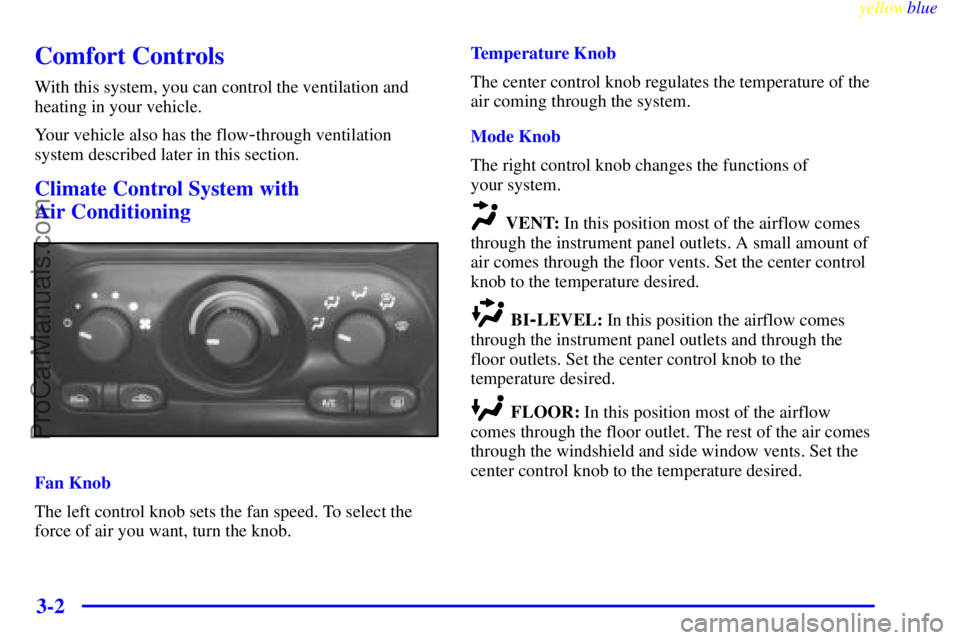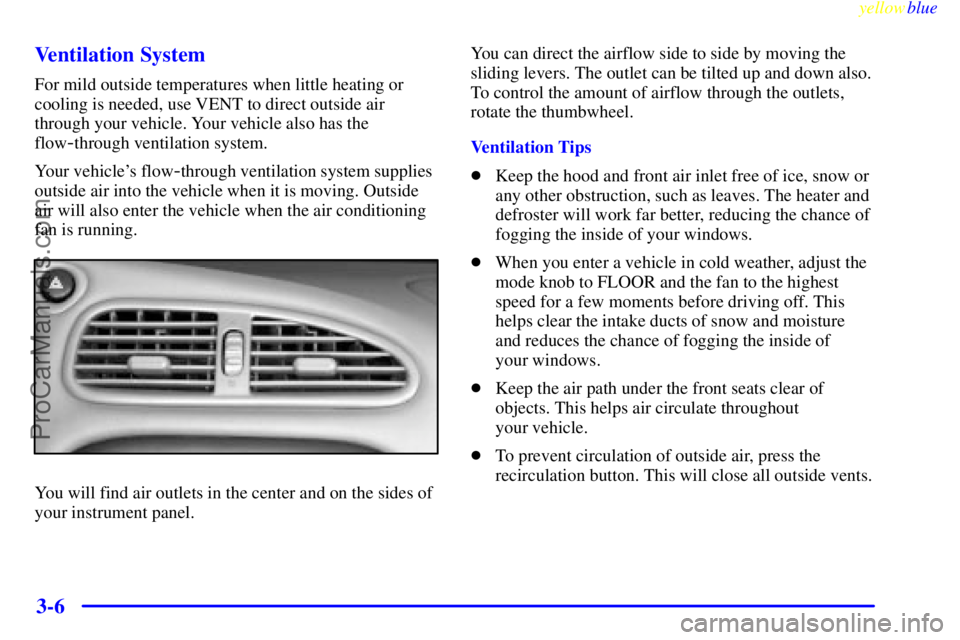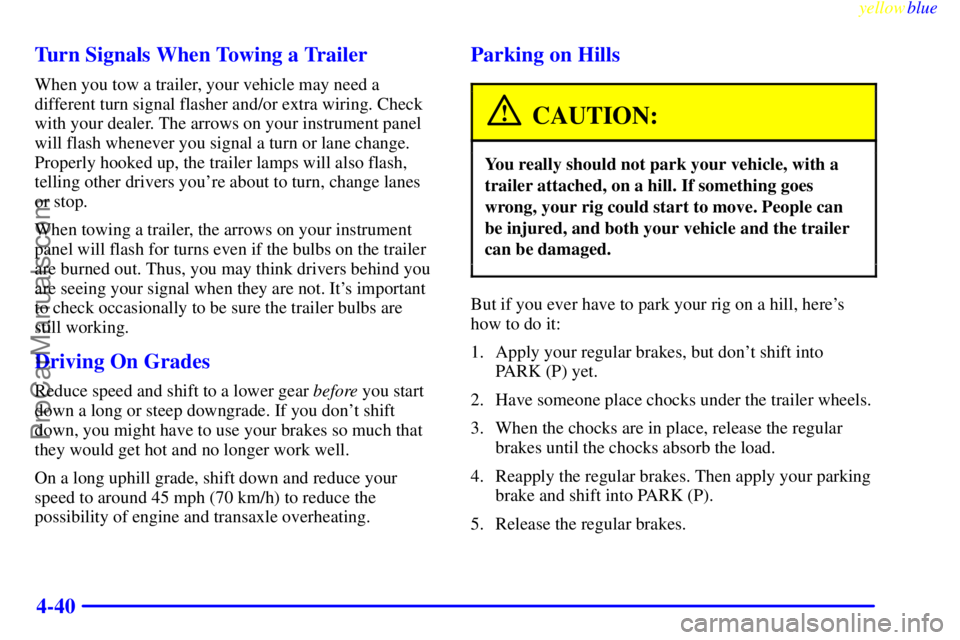Page 72 of 328
yellowblue
2-12
Trunk
CAUTION:
It can be dangerous to drive with the trunk lid
open because carbon monoxide (CO) gas can
come into your vehicle. You can't see or smell
CO. It can cause unconsciousness and even death.
If you must drive with the trunk lid open or if
electrical wiring or other cable connections must
pass through the seal between the body and the
trunk lid:
�Make sure all other windows are shut.
�Turn the fan on your heating or cooling
system to its highest speed with the setting
on VENT. That will force outside air into
your vehicle. See ªComfort Controlsº in
the Index.
�If you have air outlets on or under the
instrument panel, open them all the way.
See ªEngine Exhaustº in the Index.
Remote Trunk Release
The remote trunk release button is located on the
driver's door. Push the remote release button to
release the trunk lid. Make sure the lockout feature is
not activated.
ProCarManuals.com
Page 107 of 328
yellowblue
2-47
Ashtray and Lighter (If Equipped)
To use the lighter, just push it in all the way and let go.
NOTICE:
Don't put papers and other things that burn into
your ashtrays. If you do, cigarettes or other
smoking materials could set them on fire,
causing damage.
NOTICE:
Don't hold a cigarette lighter in with your hand
while it is heating. If you do, it won't be able to
back away from the heating element when it's
ready. That can make it overheat, damaging the
lighter and the heating element.
You can also remove the cigarette lighter to plug in
additional accessories. Be sure to follow the proper
installation instructions that are included with any
electrical accessory you install.
ProCarManuals.com
Page 120 of 328
yellowblue
2-60 Engine Coolant Temperature Gage
This gage shows the engine
coolant temperature. If the
gage pointer moves into the
red area, the light comes on
and you hear a chime, your
engine is too hot! It means
that your engine coolant
has overheated.
In ªProblems on the Road,º of this manual shows what
to do. See ªEngine Overheatingº in the Index.
Low Coolant Warning Light
This light comes on
briefly when you turn
your ignition on.
If this light comes on and stays on and you hear a chime,
the vehicle should promptly be pulled off the road and
the coolant level checked.
See ªEngine Coolantº in the Index. If there are visible
signs of steam, see ªEngine Overheatingº in the Index
before opening the hood. Have your vehicle serviced as
soon as you can.
ProCarManuals.com
Page 129 of 328
3-
yellowblue
3-1
Section 3 Comfort Controls and Audio Systems
In this section, you'll find out how to operate the comfort control and audio systems offered with your vehicle.
Be sure to read about the particular systems supplied with your vehicle.
3
-2 Comfort Controls
3
-2 Climate Control System with
Air Conditioning
3
-3 Air Conditioning
3
-4 Heating
3
-4 Defogging and Defrosting Windows
3
-5 Rear Window Defogger
3
-6 Ventilation System
3
-7 Audio Systems
3
-7 Setting the Clock
3
-7AM-FM Stereo
3
-9AM-FM Stereo with Cassette Tape Player and
Automatic Tone Control (If Equipped)3
-13 AM-FM Stereo with Cassette Tape and
Compact Disc Player with Automatic Tone
Control (If Equipped)
3
-19 Theft-Deterrent Feature (If Equipped)
3
-21 Understanding Radio Reception
3
-22 Tips About Your Audio System
3
-23 Care of Your Cassette Tape Player
3
-24 Care of Your Compact Discs
3
-24 Care of Your Compact Disc Player
3
-24 Backglass Antenna
ProCarManuals.com
Page 130 of 328

yellowblue
3-2
Comfort Controls
With this system, you can control the ventilation and
heating in your vehicle.
Your vehicle also has the flow
-through ventilation
system described later in this section.
Climate Control System with
Air Conditioning
Fan Knob
The left control knob sets the fan speed. To select the
force of air you want, turn the knob.Temperature Knob
The center control knob regulates the temperature of the
air coming through the system.
Mode Knob
The right control knob changes the functions of
your system.
VENT: In this position most of the airflow comes
through the instrument panel outlets. A small amount of
air comes through the floor vents. Set the center control
knob to the temperature desired.
BI-LEVEL: In this position the airflow comes
through the instrument panel outlets and through the
floor outlets. Set the center control knob to the
temperature desired.
FLOOR: In this position most of the airflow
comes through the floor outlet. The rest of the air comes
through the windshield and side window vents. Set the
center control knob to the temperature desired.
ProCarManuals.com
Page 132 of 328

yellowblue
3-4 Heating
On cold days, use FLOOR and the outside air button
with the temperature knob all the way in the red area.
The system will bring in outside air, heat it and send it to
the floor outlets.
Your vehicle has heat ducts that are directed toward the
rear seat. Keep the area under the front seats clear of
obstructions so that the heated air can reach the rear
seat passengers.
If your vehicle has an engine coolant heater, you can use
it to help your system provide warm air faster when it's
cold outside (0�F (
-18�C) or lower). An engine coolant
heater warms the coolant your engine and heating
system use to provide heat. See ªEngine Coolant
Heaterº in the Index.
Defogging and Defrosting Windows
Your system has two settings for clearing the front and
side windows. For each setting, adjust the temperature
control as desired.
To defrost the front window quickly, turn the
temperature control knob all the way in the red area.
Use FRONT DEFROST and adjust the fan to the highest
speed. To warm passengers while keeping the front
window clean, use DEFOG.If you select RECIRCULATION while in the VENT,
BI
-LEVEL or FLOOR modes, humid air can recirculate
inside the vehicle and allow moisture to form on the
windows. If this happens either press the A/C button
to on or select FRONT DEFROSTER or the
DEFOG modes.
Your vehicle is equipped with side window defogger
vents. The side window defogger vents are located on the
outside of the side instrument panel vents. To defrost the
side windows, turn the temperature control knob all the
way in the red area. Use FLOOR and adjust the fan to the
highest speed. To control fogging of the windows, turn
the temperature control knob all the way in the red area.
Use DEFOG and adjust the fan to the highest speed.
To defog the side windows while using air conditioning,
use BI
-LEVEL and adjust the fan to the highest speed
and press the A/C button so that the indicator light is
glowing. For added airflow to the side windows aim
the side vents toward the windows and close the
center vents.
ProCarManuals.com
Page 134 of 328

yellowblue
3-6 Ventilation System
For mild outside temperatures when little heating or
cooling is needed, use VENT to direct outside air
through your vehicle. Your vehicle also has the
flow
-through ventilation system.
Your vehicle's flow
-through ventilation system supplies
outside air into the vehicle when it is moving. Outside
air will also enter the vehicle when the air conditioning
fan is running.
You will find air outlets in the center and on the sides of
your instrument panel.You can direct the airflow side to side by moving the
sliding levers. The outlet can be tilted up and down also.
To control the amount of airflow through the outlets,
rotate the thumbwheel.
Ventilation Tips
�Keep the hood and front air inlet free of ice, snow or
any other obstruction, such as leaves. The heater and
defroster will work far better, reducing the chance of
fogging the inside of your windows.
�When you enter a vehicle in cold weather, adjust the
mode knob to FLOOR and the fan to the highest
speed for a few moments before driving off. This
helps clear the intake ducts of snow and moisture
and reduces the chance of fogging the inside of
your windows.
�Keep the air path under the front seats clear of
objects. This helps air circulate throughout
your vehicle.
�To prevent circulation of outside air, press the
recirculation button. This will close all outside vents.
ProCarManuals.com
Page 192 of 328

yellowblue
4-40 Turn Signals When Towing a Trailer
When you tow a trailer, your vehicle may need a
different turn signal flasher and/or extra wiring. Check
with your dealer. The arrows on your instrument panel
will flash whenever you signal a turn or lane change.
Properly hooked up, the trailer lamps will also flash,
telling other drivers you're about to turn, change lanes
or stop.
When towing a trailer, the arrows on your instrument
panel will flash for turns even if the bulbs on the trailer
are burned out. Thus, you may think drivers behind you
are seeing your signal when they are not. It's important
to check occasionally to be sure the trailer bulbs are
still working.
Driving On Grades
Reduce speed and shift to a lower gear before you start
down a long or steep downgrade. If you don't shift
down, you might have to use your brakes so much that
they would get hot and no longer work well.
On a long uphill grade, shift down and reduce your
speed to around 45 mph (70 km/h) to reduce the
possibility of engine and transaxle overheating.
Parking on Hills
CAUTION:
You really should not park your vehicle, with a
trailer attached, on a hill. If something goes
wrong, your rig could start to move. People can
be injured, and both your vehicle and the trailer
can be damaged.
But if you ever have to park your rig on a hill, here's
how to do it:
1. Apply your regular brakes, but don't shift into
PARK (P) yet.
2. Have someone place chocks under the trailer wheels.
3. When the chocks are in place, release the regular
brakes until the chocks absorb the load.
4. Reapply the regular brakes. Then apply your parking
brake and shift into PARK (P).
5. Release the regular brakes.
ProCarManuals.com